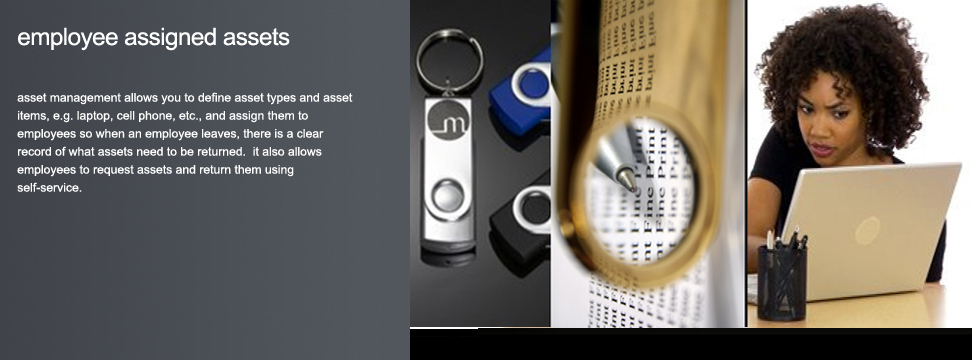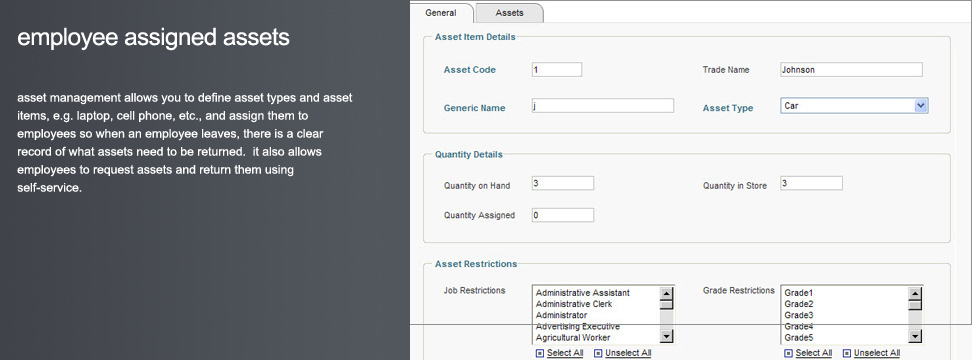Interact HRMS Asset Management Module Overview
The Interact HRMS Asset Management module is a comprehensive solution designed to help organizations manage their physical assets efficiently. This module enables companies to define various asset types, track individual assets, assign them to employees, and maintain an accurate record of all assets within the organization. With features for tracking asset details, monitoring inventory levels, and managing employee assignments, the Asset Management module streamlines the asset lifecycle, from acquisition to retirement.
Asset management is essential for organizations that rely on physical assets to support operations. By maintaining accurate records of each asset’s details, such as serial numbers, purchase dates, and current values, this module helps organizations optimize asset utilization, manage costs, and ensure accountability. Additionally, the module includes self-service features, allowing employees to request, track, and return assets, thus enhancing asset visibility and ensuring that assets are properly managed and returned when no longer needed.
Defining Asset Types and Asset Items
The foundation of the Asset Management module is the ability to define asset types and individual asset items. Asset types represent categories of assets, such as laptops, mobile phones, office furniture, or specialized equipment. For each asset type, companies can create multiple individual asset items, each with unique characteristics. This structured approach enables organizations to categorize their assets effectively, making it easier to manage, track, and retrieve asset information as needed.
For instance, within the “Laptop” asset type, individual items might include different models, each with unique serial numbers and specifications. By organizing assets into types and items, the Asset Management module allows organizations to maintain an orderly asset database that supports efficient tracking, reporting, and accountability. This categorization also helps finance and HR departments differentiate between various asset classes, supporting more accurate asset depreciation and inventory management.
Detailed Asset Information and Tracking
Each asset item within the module can be defined with detailed characteristics that allow organizations to track its entire lifecycle. This detailed information includes attributes such as serial number, purchase date, current value, and condition. By capturing these details, the module provides a complete record of each asset’s history and status, enabling organizations to monitor asset utilization and assess value over time.
Tracking the purchase date and current value is particularly valuable for financial planning, as it enables organizations to calculate depreciation and understand the residual value of assets. With this information readily available, finance teams can make more informed decisions about asset replacement and disposal. Additionally, tracking asset condition helps identify assets that may require maintenance, repair, or replacement, ensuring that employees have access to functional and reliable equipment.
Asset Assignment and Employee Accountability
The Asset Management module facilitates the assignment of assets to employees, providing a clear record of asset allocation across the organization. When an asset is assigned to an employee, the module captures essential details, including the employee’s name, assignment date, and any specific usage guidelines. This record ensures accountability, as each asset’s user is documented, making it easy to identify who is responsible for each item.
This assignment functionality is especially valuable during the employee exit process, managed in Interact HRMS through the End-of-Employment or Offboarding module. When an employee leaves the organization, the module provides a comprehensive list of assets that need to be returned, ensuring that valuable items are not lost or forgotten. This feature helps HR and administrative teams efficiently manage asset recovery, reducing the risk of unreturned assets and supporting effective resource management.
Employee Self-Service for Asset Requests and Returns
The Asset Management module includes a self-service component, allowing employees to request and return assets through a user-friendly interface. This self-service functionality empowers employees to manage their asset needs independently, reducing the administrative burden on HR and IT departments. Employees can submit asset requests for items they need, such as a laptop or mobile phone, and track the status of their requests within the system.
When an employee no longer needs an asset or is leaving the organization, they can use the self-service portal to initiate an asset return. This streamlined return process ensures that assets are returned promptly and in good condition, supporting the organization’s inventory management efforts. By enabling self-service asset management, the module promotes accountability and encourages employees to take ownership of the assets assigned to them.
Inventory Management and Asset Availability
In addition to tracking individual assets, the Asset Management module provides comprehensive inventory management features that enable organizations to monitor asset availability and usage. The module tracks three key inventory metrics:
- Quantity on Hand: The total number of assets available in the organization, regardless of their status.
- Quantity in Store: The number of assets currently in storage and available for assignment.
- Quantity Assigned: The number of assets currently assigned to employees.
By tracking these metrics, the module provides a real-time view of asset availability, making it easy for organizations to assess whether they have sufficient assets on hand to meet employee needs. For example, if the Quantity in Store for a specific asset type is low, the organization may need to purchase additional units to ensure availability. This visibility into inventory levels helps organizations optimize asset procurement and ensure that employees have access to the tools they need to perform their jobs.
Real-Time Asset Status Monitoring
The Asset Management module enables real-time status monitoring for each asset, allowing organizations to track whether an asset is currently in use, in storage, under maintenance, or pending return. This real-time status tracking helps organizations respond quickly to changing asset needs and avoid disruptions caused by asset shortages or unavailability. For instance, if a laptop is marked as “under maintenance,” HR and IT departments can anticipate when it will be ready for re-assignment or replacement.
Status monitoring is particularly valuable for organizations with large asset inventories, as it enables them to efficiently allocate resources and avoid unnecessary asset purchases. By knowing the exact status of each asset, organizations can maximize the utility of their existing inventory, ensuring that assets are used effectively and that idle assets are redeployed where needed.
Asset Lifecycle Management and Depreciation Tracking
The Asset Management module provides tools for tracking the full lifecycle of each asset, from acquisition to disposal. By maintaining a complete history of each asset’s usage, condition, and value, the module supports effective asset lifecycle management, helping organizations optimize asset utilization and plan for replacements or upgrades. This lifecycle tracking is essential for ensuring that assets remain in good condition and are replaced in a timely manner.
Additionally, the module tracks asset depreciation, providing finance teams with accurate data on each asset’s current value. Depreciation tracking is critical for financial reporting, as it allows organizations to assess the declining value of assets over time and make informed decisions about asset retirement. By incorporating depreciation data, the Asset Management module enables organizations to manage their financial resources more effectively and maintain compliance with accounting standards.
Seamless Integration with Other Interact HRMS Modules
The Asset Management module integrates seamlessly with other Interact HRMS applications, providing a unified platform for managing assets alongside HR processes. This integration allows organizations to link asset management with employee records, ensuring that asset assignments are accurately documented and easily accessible within the HR system. For example, when a new employee is onboarded, HR can assign assets through the Asset Management module or through the Onboarding module, and the assignment will automatically update the employee’s record in the HR system.
This integration also supports efficient asset tracking during the employee exit process. When an employee’s record is updated to reflect their departure, using End-of-Employment Management, the system can automatically generate a list of assigned assets that need to be returned. This integration simplifies the offboarding process and reduces the risk of unreturned assets, enhancing accountability and improving resource management.
Asset Reports and Analytics
The Asset Management module provides a variety of customizable reports and analytics tools that offer insights into asset utilization, inventory levels, and depreciation. These reports enable organizations to monitor asset usage patterns, track inventory trends, and assess the financial impact of asset purchases. By generating regular asset reports, organizations can make data-driven decisions about asset procurement, maintenance, and retirement.
For example, a company may generate a report on laptop usage to determine if additional laptops are needed for upcoming hires or if certain models require replacement due to frequent maintenance issues. These insights allow organizations to optimize asset allocation and budgeting, ensuring that assets are managed effectively throughout their lifecycle.
Summary: Interact HRMS Asset Management
The Interact HRMS Asset Management module provides organizations with a structured approach to tracking, assigning, and managing physical assets. Key benefits include:
- Comprehensive Asset Definition: Define asset types and individual items with detailed characteristics, such as serial numbers and purchase dates.
- Employee Accountability for Asset Assignments: Assign assets to employees and maintain a clear record of asset ownership and responsibility.
- Self-Service for Asset Requests and Returns: Empower employees to request and return assets through a user-friendly self-service portal.
- Inventory Management and Real-Time Status Tracking: Monitor asset availability with real-time metrics for on-hand, in-store, and assigned assets.
- Asset Lifecycle Management and Depreciation Tracking: Track asset usage, condition, and depreciation for effective lifecycle management.
- Seamless Integration with Other HRMS Modules: Link asset assignments with employee records and support efficient offboarding processes.
- Customizable Reports and Analytics: Access detailed asset reports to support data-driven decision-making on procurement and maintenance.
By combining these features, the Asset Management module enables organizations to optimize asset utilization, enhance accountability, and ensure that employees have access to the tools they need. This structured approach to asset management promotes financial discipline, supports efficient resource allocation, and improves overall operational effectiveness.


